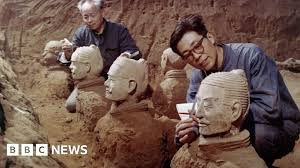
The Discovery of the Terracotta Army
A Chance Discovery
On March 29, 1974, a group of farmers in Xi'an, China, were digging a well when they unearthed fragments of terracotta pottery. What seemed like insignificant broken pieces turned out to be remnants of a much larger discovery—the first traces of the now-famous Terracotta Army. This remarkable find would forever change our understanding of ancient Chinese history and artistry.
Unearthing an Ancient Wonder
News of the farmers' discovery spread quickly, prompting archaeologists to investigate the site. The excavation unveiled a vast underground necropolis—the mausoleum of Qin Shi Huang, the first emperor of China. Commissioned by the emperor himself, the construction of this elaborate burial complex had begun in 246 BC and continued for nearly four decades.
The sheer scale of the tomb complex is astounding. While the central tomb containing Emperor Qin Shi Huang's remains is yet to be excavated, the surrounding pits have yielded thousands of meticulously crafted artifacts.
An Army Frozen in Time
Among the most captivating discoveries are the thousands of life-sized terracotta warriors and horses stationed in battle formation within the excavated pits. These figures, each standing around six feet tall and weighing approximately 600 pounds, were created to accompany and protect the emperor in the afterlife.
The level of detail in each warrior is remarkable. Each face is unique, showcasing individual features, hairstyles, and expressions. Their attire and armor vary, signifying different ranks and military roles within the Qin army. The craftsmanship reflects not only the advanced artistic skills of the period but also the military might and meticulous organization of the Qin dynasty.
The Terracotta Army Today
The discovery of the Terracotta Army has provided invaluable insights into the military practices, culture, and artistry of ancient China. Today, the site stands as a UNESCO World Heritage site, drawing visitors from around the globe.
While the majority of the army remains in its original location in Xi'an, facing east towards potential enemies, a select number of figures have been carefully excavated and restored for display in museums worldwide. These exhibitions offer a glimpse into this ancient wonder and provide a tangible connection to China's rich history.
FAQs
1. When was the Terracotta Army discovered?
The Terracotta Army was discovered on March 29, 1974.
2. Where is the Terracotta Army located?
The Terracotta Army is located in Xi'an, Shaanxi province, China.
3. Why was the Terracotta Army built?
The Terracotta Army was built to accompany and protect the first emperor of China, Qin Shi Huang, in the afterlife.